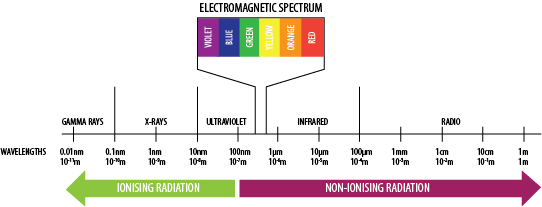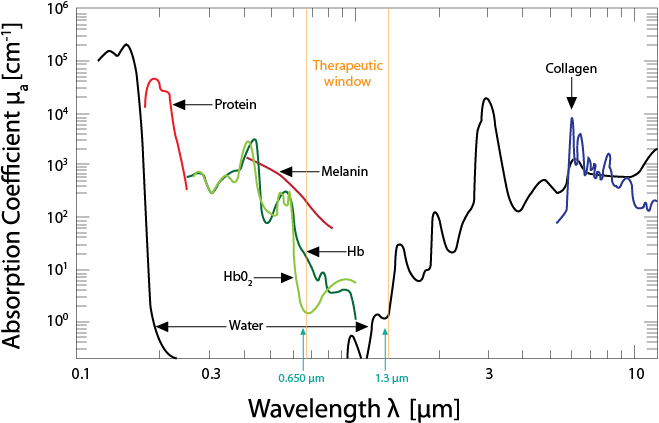Laser Education
- Home
- Laser Education
What is laser power and how does it affect photobiomodulation (PBM)?
The laser light energy is measured by the laser power.
Power seems simple but simply stating the output power does not relate the whole story when discussing therapy laser treatment. Not only is power important, but also the size of the area that is being treated. Typical power units for a laser are watts (abbreviated as W). Power is a measure of the number of photons emitted from the laser each second. Early therapeutic lasers had very low powers (less than 0.5 W) and very small beam areas (or spot sizes); consequently, early studies were often disappointing because the low powers were not able to provide sufficient number of photons to reach deeper affected tissue.
The Food and Drug Administration (FDA) classifies laser according their output power and recognizes four major classes (I to IV) of lasers, including three subclasses (IIa, IIIa, and IIIb).In December 2003, the FDA approved the first Class IV laser for the relief of minor muscle and joint pain.In October 2006, LiteCure was formed and FDA approval for the LCT-1000 a Class IV therapy laser was granted in February, 2007. LiteCure lasers are class IV lasers; they have an output power that is greater than 0.5 W.
Because Class IV lasers have a higher output power, there are some additional safety considerations that should be followed when using a Class IV laser. Eye safety is the most important consideration and the laser light should not be directed into an eye. The practitioner and patient should wear approved safety glasses for further protect from inadvertent beam reflections.
It is important to note that the LiteCure lasers not only have higher power but also have a larger beam area, making them better capable of delivering therapeutic dose to larger treatment areas.
Why are higher powers needed?
Simply stated the greater the number of photons delivered to the surface, the greater the number of photons at any tissue depth. There is a threshold, a minimum number of photons that are needed to “turn on” the therapeutic effects of laser light. Hundreds of scientific studies have been done in vitro and have characterized the dosages needed to achieve a cellular response with light. These studies provide a baseline for the amount of laser energy needed to achieve results at the cellular level. PBM therapy is non-invasive; the light is applied to the surface of the skin. Some of that light is reflected by the skin or absorbed by other chromophores that are not associated with the injured cells and therefore do not contribute to PBM. Sufficient dose needs to be applied to the skin so that despite these losses sufficient dose reaches the skin and PBM occurs at the target tissue.
What are the key factors needed to maximize penetration to the target tissue?
For PBM to occur, light needs to reach the mitochondria of the damaged target tissue. Laser therapy is applied to the surface of the skin. The best clinical results are achieved when a sufficient amount of light (number of photons) reaches the target tissue. There are a number of factors that can help maximize the light that reaches the target tissue. These include: proper wavelength selection, sufficient laser power, reducing reflections, and minimizing absorption by molecules not involved in photobiomodulation.
The class 4 difference!
| CLASS 3 | CLASS 4 |
|---|---|
| 1. Lower Power Class III lasers have a maximum power output of 500 milliwatts (or 1⁄2 of a watt). This means that during a given amount of time, less energy is delivered to target structures, especially those deeper within the body.  | 1.Higher Power Class IV lasers operate at powers above 500 mW. These lasers are able to deliver more therapeutic energy within a given amount of time to target structures deep within the body.  |
| 2. Extended Treatment Times Class III lasers require longer treatment times to deliver comparable therapeutic dosages. As a rule, the lower the laser power, the longer the treatment time, given an equivalent dosage.  | 2. Expedited Treatment Times Class IV lasers are more powerful and therefore able to facilitate quicker treatments. A 15 watt laser can deliver a comparable dose 30 times faster than a 500 mW laser.  |
| 3. Limited Treatment Area. Treatment methods with Class III lasers rely on treating small points on the body, typically directly over the site of pain. Since these lasers are less powerful, they must remain in the same place longer to deliver an adequate dose.  | 3.Expanded Treatment Area Class IV lasers are able to treat larger areas over multiple regions, addressing not only the direct site of pain, but referring sites as well. More power means quicker dosing, which leaves additional time for more extensive and uniform coverage.  |
| 4. Treat Superficial Structures Only Due to the power limitations, and thus extended treatment times, Class III lasers are most clinically effective for treating superficial muskuloskeletal conditions, as such conditions typically require minimal dosages.  | 4. Treat Deep and Superficial Structures Class IV lasers can treat both superficial and deep musculoskeletal conditions. Since these lasers are more powerful, they can deliver a higher dosage more quickly to a larger area, making them ideal for treating deeper structures.  |
minimize reflection – how can loss from reflection be minimized
- How? Hold Treatment head perpendicular to the skin: One way to minimize reflection losses is to make sure that the light enters perpendicular to the surface (hold the treatment head perpendicular to the surface).
- How? Treat on-contact: Light will be reflected at any interface it travels through. The figure to the left compares off contact and on contact treatment. With off contact treatment in the figure, there are two additional interfaces where light is reflected (treatment head-air) and (air-skin). By treating on contact, these are replaced by one interface (treatment head-skin).

Electromagnetic Spectrum
Terminology Commonly Used: Spot Size
Symbol: As
Units: cm2
Definition: Area of the beam on a surface. Beam area will depend on treatment head used and the distance the treatment head is held from the surface.
Instead of beam area, laser physicists use laser “spot size.” The spot size is either the beam radius or beam diameter, depending on the definition used. This is further complicated because the intensity of Gaussian laser beams decreases from a central maximum gradually to 0 at the edges. Since there is no clearly defined edge at which to measure the beam’s radius or diameter, “spot size” will depend on the spot size definition used (e.g., full width at half maximum or distance from maximum irradiance to irradiance of 1/e2). Nevertheless, by using a scanning application of PBM treatment, any inhomogeneities in the beam irradiance are averaged over the whole treatment area.
Symbol: At
Units: cm2
Definition: Area of the skin surface that is treated. For LiteCure lasers, this area is larger than the beam area.
Symbol: t
Units: s
Definition: Total time of a treatment to entire treatment area.
Terminology Commonly Used: Frequency
Units: hertz (Hz) or s-1
Definition: When referring to therapy lasers, most practitioners use the term frequency to mean the pulse frequency of the laser. Therapy lasers can operate in continuous or pulsed mode. The pulse frequency is the number of times the laser is turned on and off during a second.
Terminology Commonly Used: Power
Units: watt (W)
Definition: Radiant energy emitted per unit time.
Symbol: ts Units: s
Definition: Time that surface is exposed to the beam.
For scanning treatment with a LiteCure laser, the total treatment area is covered. Assuming a uniform treatment to the skin, then the total exposure time of the skin to the beam during the treatment is related to the total treatment time by the ratio of the beam area to the treatment area. Hence, ts = t x (As/At).
Symbol: D
Definition: This term is used for pulsed lasers. It is the percentage of one period in which the laser is emitting. For LiteCure lasers operating in pulsed mode, the duty cycle 50%.
Unit: joule (J)
Definition: The total energy delivered during a treatment is determined by multiplying the average power during the treatment by the total treatment time.
Terminology Commonly Used: Power density
Symbol: E
Units: W/cm2
Definition: The output power of the laser divided by the beam area. The power intensity at the surface of the skin.
Units: J/cm2
Standard Dosimetry Definition:
Dose = Irradiance x exposure time
= E x ts
Units: joules/cm2 = J/cm2
For calculation of dose delivered during scanning:
First, let us assume that the treatment beam is uniform.
In this case, the irradiance would then be the power divided by the beam area,
E=F/As.
With the exposure time ts = t x (As/At).
Putting these together: Dose = Irradiance x exposure time
= (F/As) t x (As/At)
= F t /At
This is the total energy delivered divided by the total treatment area.
For LiteCure Lasers, the dose will be the total energy delivered to an area divided by the total area (skin surface area) to which it was delivered. This assumes that scanning covers the treatment area evenly to distribute an even dose to the tissue. By scanning the entire area evenly any inhomogeneities in the beam are averaged over the whole treatment area.
Symbol: λ
Units: nm
Definition: The distance between two consecutive peaks of an electromagnetic wave.
Terms & definitions
Term: adenosine triphosphate
Abbreviation or Other Terminology Used: ATP
Definition: Molecule in the cell that transports chemical energy for metabolism.
Term: chromophore
Definition: The part of the molecule that captures light energy.
Term: continuous wave
Abbreviation or Other Terminology Used: CW
Definition: A laser which runs at constant output power.
Term: cytochrome c
Definition: A component of the electron transport chain in mitochondria.
Term: electromagnetic radiation
Definition: The radiant energy released by certain electromagnetic processes. Electromagnetic radiation includes radio waves, microwaves, infrared radiation, visible light, ultraviolet radiation, X-rays, and gamma rays. See also electromagnetic spectrum.
Term: electromagnetic spectrum
Definition: The range of wavelengths and frequencies of electromagnetic radiation (see figure below).
Term: endogenous
Definition: Growing or originating from within an organism.
Term: mitochondrion (pl. mitochondria)
Definition: An organelle found in large numbers in most cells, in which the biochemical processes of respiration and energy production occur.
Term: near-infrared (NIR) window
Abbreviation or Other Terminology Used: therapeutic or optical window
Definition: The range of wavelengths from 650 nm to 1350 nm where light has its maximum depth of penetration in biological tissue (see figure below). Visit the Wavelength Selection page for details about water absorption and to see the various absorption coefficients as a function of wavelength on a linear scale.
Term: nitric oxide
Abbreviation or Other Terminology Used: NO
Definition: Important cellular signaling molecule involved in many physiological and pathological processes.
Term: protocol
Definition: Predefined treatment sequence programmed into the laser software.
Term: reactive oxygen species
Abbreviation or Other Terminology Used: ROS
Definition: Chemically reactive molecules containing oxygen.
Term: vasodilation
Definition: The widening of blood vessels, thus resulting in increased blood flow.






